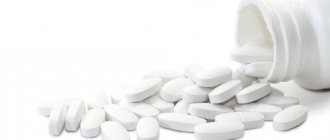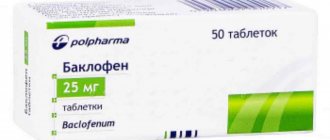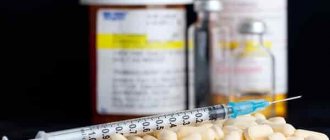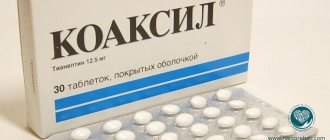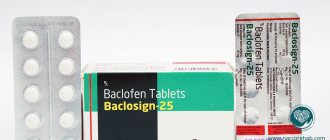Content:
- Effect of Phenobarbital on the body
- Effect on humans of Phenobarbital used in high doses
- When narcotic medicine is strictly prohibited
- How addiction develops
- How to understand that a person is “sitting” on Phenobarbital
- What does phenobarbital addiction lead to?
- How to deal with addiction
Phenobarbital drug addicts use it for a reason.
It quickly causes physical dependence if used uncontrollably. The drug belongs to the pharmacotherapeutic group “Anticonvulsants” and is a representative of barbiturates. Prescribed to patients with various forms of epilepsy, with the exception of absence seizures. Also, sometimes narcologists prescribe it to alcoholics suffering from painful withdrawal symptoms. Shows pronounced hypnotic and sedative properties.
Interaction
Combination with drugs that depress the nervous system, as well as ethanol-containing drugs and ethanol can lead to increased CNS depression. Caffeine reduces the hypnotic effect of Phenobarbital.
Interaction with MAO inhibitors and methylphenidate causes an increase in plasma levels of phenobarbital, so that the toxic effect and inhibitory effect on the nervous system are enhanced.
The intensity and duration of action of the following drugs may be reduced when combined with Phenobarbital: GCS, chloramphenicol , Dacarbazine , Metronidazole , Carbamazepine and anticonvulsants from the succinimide group, anticoagulants ( Indandione and Coumarin ), Doxycycline , Chlorpromazine , vitamin D , Corticotropin , Cyclosporine , digitalis glycosides , Quinidine , estrogen-containing oral contraceptives, tricyclic antidepressants, Fenoprofen , Phenylbutazone , xanthines.
Concomitant use with acetazolamide can provoke osteomalacia and rickets .
Taking valproic acid leads to an increase in plasma levels of phenobarbital, which can cause pronounced sedation and lethargy. The level of valproic acid in plasma decreases slightly.
Combination with Verapamil , Felodipine , Nimodipine also leads to a decrease in their plasma levels.
Interactions with Halothane , Ftorotan , Enflurane and Methoxyflurane may cause increased metabolism of anesthetic , which increases the likelihood of toxic effects on the liver (and also on the kidneys in the case of Methoxyflurane ).
Taking Griseofulvin leads to a decrease in the degree of its absorption from the intestine.
Combination with maprotiline in high dosages reduces the seizure threshold and the anticonvulsant effect of barbiturates.
The effectiveness of Paracetamol may be reduced when taken with Phenobarbital. Hepatotoxicity may develop.
A daily dose of Pyridoxine of 200 mg reduces the level of phenobarbital in plasma, and simultaneous use with Primidone and Felbamate , on the contrary, increases it.
If there is a lack of folic acid in the body, taking medications with this acid leads to a decrease in the effectiveness of Phenobarbital.
Combination with other sedatives can lead to severe respiratory depression.
Effect of Phenobarbital on the body
The drug has an effect on the cerebral cortex and inhibits the functioning of the thalamus. Due to this, a pronounced hypnotic and sedative effect occurs. Its anticonvulsant activity is achieved by reducing neuronal excitability provoked by psychotropics or an existing mental disorder.
The sleep that occurs after using the drug Phenobarbital is very different from normal physiological sleep. Thus, the duration of the REM sleep phase is reduced, as are the third and fourth stages of slow sleep. The structure of human night rest is undergoing dramatic changes. The hypnotic effect appears within an hour after taking the medicine and lasts up to 8-12 hours. But after two weeks of regular use of Phenobarbital, its hypnotic effect becomes weaker.
If you combine the medication with antispasmodics, you will be able to quickly achieve positive dynamics in neurovegetative pathologies. The drug can reduce the activity of metabolic reactions and inhibit the main centers of thermoregulation. Because of this, the drug addict’s body temperature drops significantly.
Overdose
Overdose is the most common cause of death from barbiturates. There are 2 reasons why it occurs:
- accumulation of barbituric acid derivatives in body tissues;
- development of drug tolerance.
Due to accumulation, barbiturates are constantly deposited in the body. The consequence of this is a strong dose-dependent effect. If the patient always took the same amount of the drug and at some point increased the dose by 10%, an overdose may occur.
The development of tolerance is due to the fact that the body tries to fight drugs. Special antibodies and enzymes are produced to break down the drugs. This leads to the fact that addicted people need to constantly increase their dose. When the dose is toxic, an overdose occurs. Some may use several times a day, while others experience an overdose due to one dose of a standard dose.
How to recognize
Usually such people look like drunk people, but they do not smell of alcohol. More than half of these people lose consciousness completely, and their breathing and heartbeat may be impaired.
It happens that drug addicts experience convulsions and fasciculations. There may be profuse vomiting, heavy sweating, and a lot of saliva coming out of the mouth.
The pupils usually do not change in size. The drug addict's breathing is rare and shallow, the pulse is thready and slow.
If you witness such a situation, there is no time to find out what kind of drug the overdose occurred; first aid must be provided.
What to do
Call an ambulance immediately after you are sure that you are not in danger. In cases of barbiturate overdose, the patient's breathing and heartbeat should always be monitored.
If the person is unconscious, begin chest compressions. According to the protocol, first you need to do a heart massage, and not mouth-to-mouth breathing. This is due to the fact that there are still reserves of oxygen in the blood that can be delivered to the brain. And only after 15 presses you need to do mouth-to-mouth breathing. The intensity of pressing should be as follows: 2 times in 1 second.
If the patient is vomiting, be sure to turn the patient's head to the side to prevent aspiration of the vomit. Before performing artificial respiration, make sure that there are no vomit residues in the mouth; if there are any, remove them with a handkerchief or rag wrapped around your finger.
Provide a comfortable environment. If it is cold, cover the patient; if it is hot, undress him and wipe his head with a damp towel. Provide access to fresh air. The ambulance will then be able to provide symptomatic and supportive therapy, and will take the patient to intensive care for further treatment.
Sometimes antidotes are administered, such drugs include: corazol or bemegride. Please note that these medications are ineffective in case of severe overdose; they can only help with minor intoxication.
Effect on humans of Phenobarbital used in high doses
An overdose of the drug causes serious harm to health. There are disruptions in the transmission of nerve impulses, and consciousness changes. The most dangerous complication is destruction and damage to the main nerve canals. With this pathology, symptoms such as:
- psychomotor excitability;
- inability to remain calm or sit still for even a short time;
- sense of anxiety.
If a person takes the drug in high doses for a long time, his nerve channels completely atrophy. But nerve impulses continue to look for a way out, so they pass along alternative courses of movement. As a result, the addict:
- involuntary contractions of the facial muscles occur (facial expressions look very strange);
- the tongue falls out;
- there is copious secretion of saliva;
- tremor of the fingers is observed.
The effect of Phenobarbital on the human body is very specific. In many drug addicts, the respiratory center is depressed. They begin to inhale less air. There is a feeling of lack of oxygen. Choking may develop.
Drug poisoning can be acute or chronic. A specific toxic dose for humans has not been established. It depends on age, gender, body weight, and health status. If you drink one gram of medication at a time, symptoms of acute intoxication will most likely appear.
The lethal dose of Phenobarbital is from two to ten grams. An addict develops symptoms reminiscent of alcohol poisoning:
- vomit;
- nausea;
- dizziness;
- stomach ache;
- severe headaches;
- problems with orientation in space;
- surges in blood pressure.
Signs of a neurological disorder also make themselves felt. Therefore, if a dose of Phenobarbital exceeding one gram is taken, you should receive qualified medical care as soon as possible.
Origin and history of the drug
Phenobarbital is a derivative of barbituric acid. It was synthesized by Adolf von Bayer in 1863. The drug became a huge discovery for its time, as it allowed psychiatrists to pacify a violent person who was in this state for a variety of reasons.
Barbital was officially introduced to the world in 1903, after which its improved versions began to appear, in particular phenobarbital.
Barbiturates skyrocketed in popularity as many people used it to relieve stress or insomnia. Later, problems and complications caused by the drug, as well as dependence on it, began to be identified. Cases of drug overdose often occurred, as some liked the state caused by barbiturates.
When narcotic medicine is strictly prohibited
The official instructions indicate the following contraindications to treatment with Phenobarbital:
- individual intolerance to barbiturates;
- severe anemia;
- chronic alcoholism;
- liver/renal failure;
- severe pathologies of the respiratory system;
- diabetes;
- pregnancy, lactation;
- tendency to develop drug/alcohol addiction (for example, if there is a history of these diseases);
- depression;
- suicidal tendencies;
- acute pain of any localization of unknown origin.
Under no circumstances should you combine the medicine with other depressants or alcohol. Such combinations increase the effects of Phenobarbital and lead to deadly complications.
How long does Corvalol stay in the blood?
Depending on the patient’s individual health indicators, the intensity and duration of drug treatment, the period of removal of the substance from plasma in an adult ranges from 50 to 120 hours. For those to whom these numbers are important, you should know that the circulatory system will be cleared of the drug in approximately 5-8 days.
This is the information you need to focus on if you have to take a drug test. According to the law, if barbiturates are detected in the blood, it is necessary to undergo a chemical and toxicological examination in two stages:
- preliminary analysis that will determine or refute the presence of narcotic drugs;
- confirmatory testing designed not only to confirm previous results, but also to establish the concentration of the compound.
For each type of examination, acceptable values are set within the limits of medicinal parameters (1000 ng/mg). When using the drug in doses prescribed by your doctor, the threshold values will never be exceeded.
How addiction develops
The medication gives a lasting effect of relaxation and tranquility. Therefore, many people, after completing a course of treatment, decide to continue using it. Since the active substance of the drug is eliminated from the body rather slowly, daily therapy often contributes to an overdose. The composition accumulates faster than the kidneys have time to neutralize and remove it.
Over time, the usual dose ceases to provide the desired feeling of euphoria. Then the novice drug addict increases it. This behavior can lead to death from overdose.
Coding
Coding is a scientifically unproven addiction treatment method. Coding is based on the use of hypnosis or suggestion methods. In practice, these methods do not produce results, because physical dependence should be treated only in combination with long-term psychological therapy and drug support.
If you are offered coding as a method of treatment for addiction, you should not contact such centers or clinics. Coding is a technique that extracts money from the patient, but does not produce results.
How to understand that a person is “sitting” on Phenobarbital
You can recognize an addict by the following symptoms:
- detached look;
- complete lack of initiative;
- inability to focus on anything;
- lack of interest in what is happening around;
- constant drowsiness;
- excessive timidity;
- inadequacy and aggression towards relatives and friends.
Of course, all these signs are vague and non-specific. Therefore, if relatives do not know what medicine the addict is taking, they most likely will not guess anything. If they are aware of recent treatment with Phenobarbital, then they should think about the fact that the addict is continuing therapy without the knowledge of the doctor.
Important note!
Procedural violations
And these are standard violations by inspectors or doctors, which also make the use of evidence unacceptable. Please note that the procedures for determining intoxication themselves are nothing more than the collection of evidence.
We wrote a separate article about such procedural violations of officials and how to cancel deprivation of rights on their basis. Here are the most common illegal methods.
- Any medical examination must be preceded by a roadside alcohol test; without it, a referral for a test is illegal; and on the road neither barbiturates nor any other drugs will be able to be found on you; if you were immediately sent to a medical facility, then this is an almost 100 percent opportunity to avoid deprivation.
- On the road you should be “blowed through” using video footage or 2 witnesses - if this did not happen, then there was no “blow off”, which means see point 1.
- During a roadside inspection, a “breathalyzer” with a verifier’s mark and a verification certificate must be used. This data is reflected in the inspection report.
- In the hospital, you should also first be cleared and only then, if there are clinical signs, they should be tested for barbiturates and other narcotic drugs.
- The doctor himself must have a medical education, undergo training in toxicological studies, and the medical institution must have the appropriate license.
What does phenobarbital addiction lead to?
Many drug addicts think that since Phenobarbital is a pharmaceutical drug, it cannot cause serious harm to health. This is a deep misconception. Persons with a significant drug history often encounter:
- cardiovascular diseases;
- swelling;
- dermatitis;
- respiratory failure;
- unbearable pain in the back;
- mental disorders;
- very slow wound healing;
- nightmares;
- inhibition of speech and mental reactions.
The patient begins to behave strangely and inappropriately. He is constantly afraid of something. Periodically he has panic attacks. The condition is complicated by visual and auditory hallucinations.
How to deal with addiction
To overcome the disease, you must completely stop taking the drug and any other barbiturates. The most reasonable thing is to contact a narcologist and undergo the treatment he suggests in an inpatient drug clinic.
Considering that the drug often causes suffocation, it is better for the drug addict to be constantly under medical supervision. In addition, sudden withdrawal from the drug sometimes results in coma.
Doctors always reduce the dose of Phenobarbital gradually to avoid negative changes in the patient's physical and mental condition. After about two weeks, withdrawal symptoms begin to subside, and health improves.
To fully recover, you need to devote time to rehabilitation. It lasts much longer than two weeks. You can go through it at a rehabilitation center.
Analogs
Barbiturates, as a pharmacological group, are most similar in action to sedatives, alcohol and opiates. Alcohol or opiates are thought to potentiate the effects of barbiturates.
Currently, approximately 10 drugs from the barbiturate group are registered in the Russian Federation. They are mainly sold by prescription and used for anesthesia or sedation. Such drugs include:
- Butalbutal;
- Nembutal;
- Alurat;
- Secobarbital;
- Aprobarbital.
The main representative of the group of barbiturates is phenobarbital. This is what drug addicts abuse most often.
Valocordin and Corvalol are also dangerous. Drugs can cause mental dependence, which can become physical. These drugs contain a small dose of phenobarbital, which causes all the effects of the drug.
Literature:
- Drug complications and ways to eliminate them: handbook. for doctors / I. B. Mikhailov, I. V. Markova. - M.; St. Petersburg : DILYA, 2004. - 329 p.
- Pharmacotherapy in neurology and psychiatry / ed. S. D. Enn and J. T. Coyle; lane from English edited by O. S. Levina; trans.: O. S. Andreev, K. M. Petrov, T. V. Naimushina. — Moscow: Med. information agency, 2006. - 799 p.
- Adverse drug reactions = Adverse drug reactions. General information / [Reichart D.V. et al.] ; edited by D. W. Reichart. - Moscow: Litterra, 2007. - 248 p.
